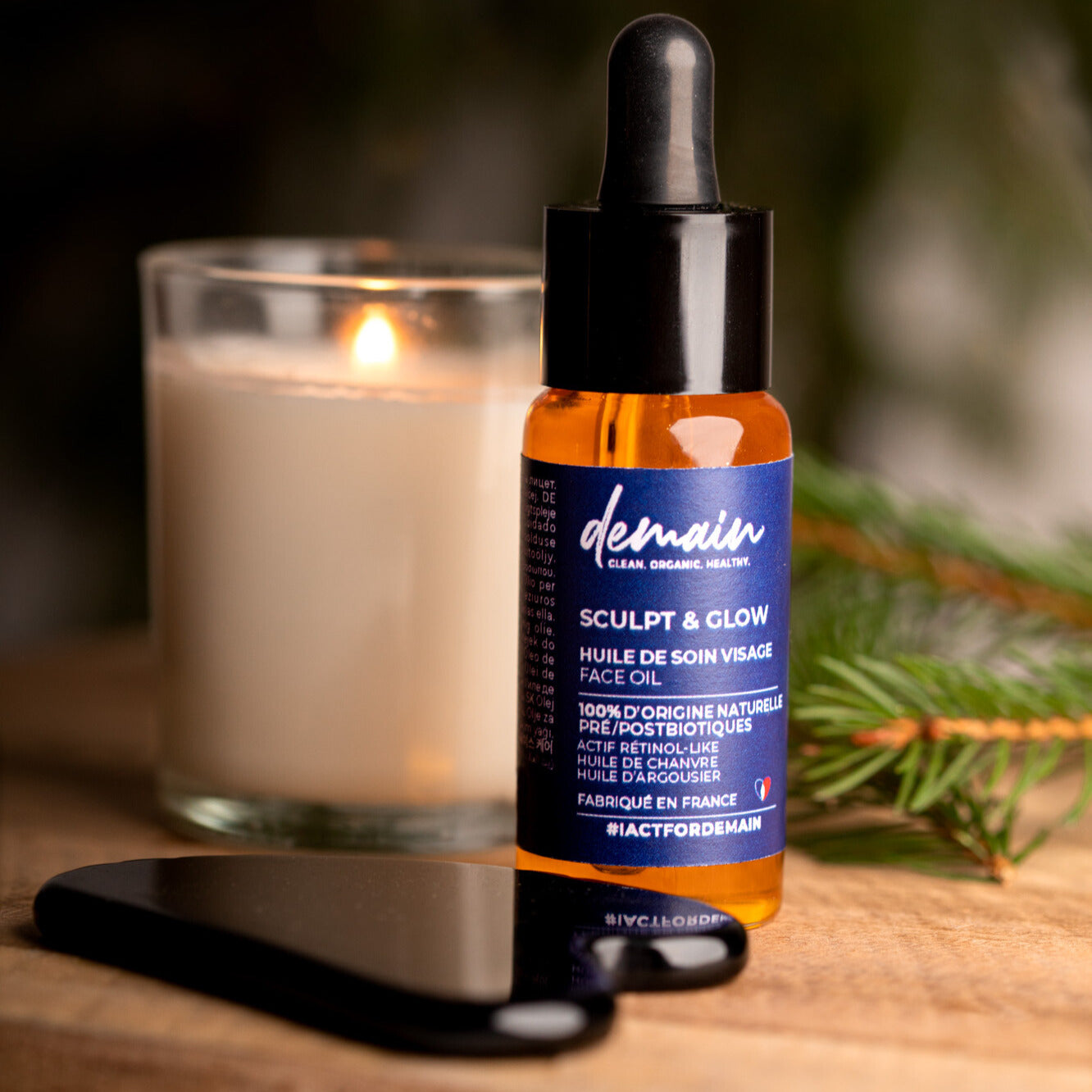Summer, sun, wind and sea can leave your skin dehydrated, rough and dull. Understanding the causes and symptoms of dehydrated skin is essential to knowing how to rehydrate and care for your skin. Whether your skin is dry, oily or thin, discover how to regain a fresh and radiant complexion despite the stress of summer.
Understanding Skin Dehydration
Skin dehydration occurs when the epidermis, the upper layer of the skin, can no longer retain enough water. Water is an essential element for the proper functioning of our skin. In summer, various external factors such as the sun, wind and sea alter the hydrolipidic film of the epidermis, leading to greater water loss. This situation is exacerbated by temperature differences between outdoors and air-conditioned interiors. Unlike dry skin which lacks lipids, dehydrated skin lacks water and hygroscopic compounds.
Identify the causes of dehydrated skin
Despite its universal aspect, skin dehydration is not always due to the same factors. It can result from external causes, such as climatic conditions, with cold , wind and UV exposure which alter the hydrolipidic film of the epidermis. However, it can also be caused by internal factors, such as hormonal changes, certain chronic diseases such as diabetes, or insufficient water consumption. Lifestyle habits, such as smoking and excessive alcohol consumption can also contribute to skin dehydration. Finally, it should be noted that stress, fatigue and the use of unsuitable cosmetics can lead to skin dehydration.
Cold, wind and UV: environmental factors
Exposure to cold, wind and UV rays is notoriously detrimental to skin hydration. Cold and wind can dry out the skin, while exposure to UV rays increases water loss, weakens the epidermis' hydrolipidic film and accelerates its aging. These extreme weather conditions are often encountered during seasonal changes, particularly during summer and winter.
Cold weather causes the skin's blood vessels to constrict, reducing blood circulation and therefore the supply of nutrients and oxygen. This results in dull, dry and less elastic skin.
Wind reinforces the drying effect of cold by increasing the evaporation of water from the surface of the skin. Wind can also carry pollution particles which, when deposited on the skin, modify the composition of the hydrolipidic film and promote dehydration.
UV rays are also harmful to the skin. They are able to penetrate the upper layers of the epidermis and cause damage at the cellular level. This can lead to erythema (sunburn), accelerated skin aging and an alteration of the skin barrier, promoting dehydration.
Stress and fatigue: internal factors
Stress and fatigue have a significant impact on our skin. They lead to excessive secretion of cortisol, a hormone with harmful effects on our skin, particularly by promoting dehydration.
Chronic stress can increase oxidative stress, which is detrimental to skin health. Skin that is subjected to prolonged stress loses its suppleness and becomes thinner, which increases dehydration.
Similarly, fatigue, especially when chronic, can disrupt the skin's moisture barrier, leading to skin dehydration. Lack of sleep reduces our skin's ability to regenerate and retain water, again promoting dehydration.
It is therefore essential to take these internal factors into account to understand and treat skin dehydration.
The impact of tobacco and alcohol on the skin
Smoking and drinking alcohol have harmful effects on the skin, especially when it comes to dehydration. Smoking reduces the supply of oxygen to the cells of the epidermis, which affects cell renewal, leaving the skin dull and promoting the appearance of wrinkles.
As for alcohol, it acts as a diuretic, speeding up the process of eliminating water from the body. This excessive elimination of water results in dehydration of the skin, which results in a loss of radiance, a feeling of tightness and a rough appearance.
These effects can be exacerbated in summer, when skin is already subject to dehydration due to heat and sun exposure. Smoking and alcohol consumption can therefore worsen the signs of dehydration and contribute to a decline in skin health.
The telltale signs of dehydrated skin
Loss of shine and feelings of tightness
A loss of radiance is characterized by a dull, less luminous complexion. This loss of luminosity is due to a decrease in water in the epidermis, making the skin less reflective of light.
As for feelings of tightness, they are a common sign of skin dehydration. These feelings of discomfort are generally felt after cleansing the face or showering, when the water has removed the protective hydrolipidic film of the epidermis.
Itching and dull complexion: other symptoms
Itching is another common symptom of dehydrated skin. It can be localized or spread across the body, and is often more intense after a shower or bath. A dull complexion is also an indicator of dehydration. The skin loses its glow and may even appear grayish. Dehydration can also make the skin tone uneven, with some areas drier and others oilier. This is a sign that the skin is having trouble retaining water and maintaining optimal hydration levels.
Rough and thin skin: advanced signs
Rough and thin skin are advanced signs of skin dehydration that should not be ignored. Rough skin is usually caused by the accumulation of dead skin cells on the surface of the epidermis. It can feel rough to the touch and have a scaly appearance. In addition, thin skin is often a sign of a lack of elasticity, a direct result of low water content. It can also show more pronounced fine lines, especially around the eyes and on the cheeks. These symptoms, along with itching and dullness, are signs of severe skin dehydration.
How to treat dehydrated skin?
To treat dehydrated skin, it is essential to adopt an appropriate skincare routine. The first step is the daily application of a moisturizer . Enriched with moisturizing active ingredients such as original hyaluronic acid , it helps retain water in the epidermis.
Complete with a serum under your cream for a boost of hydration. This product, more concentrated in active ingredients, offers deep hydration.
Finally, be sure to use gentle hygiene products that do not alter the hydrolipidic film, the skin's barrier function.
Also note that some drug treatments can cause skin dehydration. In this case, an appointment with your dermatologist may be necessary to adapt your skincare routine.
Dehydrated or dry skin?
Although these two terms are often used interchangeably, dry skin and dehydrated skin are not the same thing. Dry skin is a type of skin, linked to insufficient sebum production. It is therefore often rough, with a tendency to flakes and irritations. Conversely, dehydrated skin is a skin condition that can affect all skin types. It is characterized by a lack of water in the epidermis, which can be caused by different factors such as climatic conditions, stress or poor diet. The care to adopt will therefore be different depending on these two issues.
Treating dehydrated skin: what to do
To treat dehydrated skin, several actions are essential to add to your daily routine. They concern both lifestyle and skin care.
First, internal hydration is essential: drinking enough water is the first step to preventing skin dehydration. This advice applies to all skin types, normal, dry, oily, etc.
Next, the choice of cosmetic products is crucial. Choose moisturizing and nourishing treatments, which will allow your skin to retain water and maintain its suppleness.
Finally, applying a treatment after showering or bathing is a step that should not be overlooked. Hot water and soap can indeed alter the skin's hydrolipidic film. A suitable treatment will restore this natural protection.
- Choose mild soaps or shower gels without superfatted cleanser.
- Apply moisturizers regularly, such as a rich day or night cream.
- Consume fruits and vegetables rich in water, which will help hydrate your skin.
- Avoid prolonged exposure to the sun, which accelerates the skin's dehydration process.
Choosing the right cleaner: a crucial step
When it comes to choosing a cleanser for dehydrated skin, there are some key points to consider. Look for gentle products, avoiding harsh cleansers that can strip the skin of its natural oils. Water-based cleansers can be a good choice, such as micellar waters or cleansing milks. They are formulated to gently cleanse while hydrating the skin.
Cleansers rich in amino acids , such as soy protein, can also be beneficial. They deep cleanse while preserving skin's elasticity. Be sure to avoid ingredients that can dry out skin, such as alcohol or parabens, especially on your face.
In summary, the ideal cleanser for dehydrated skin should:
- Be gentle and moisturizing
- Contain nourishing ingredients
- Be free of drying ingredients
- Be tailored to your specific skin type (dry, oily, combination, etc.)
Remember that every skin is unique and what works for one person may not work for another. It may be necessary to try different cleansers to find the one that works best for your skin.
The importance of deep hydration
Deep hydration of the skin is a fundamental aspect in the fight against dehydration. It aims to restore the optimal water level in the different layers of the epidermis. For this, specific care is necessary.
Moisturizing serums, rich in active ingredients such as hyaluronic acid or ceramides, are particularly effective for deeply hydrating the skin. Indeed, their light and fluid texture allows better penetration of the active ingredients.
Hydrating masks also provide intense hydration. Used once or twice a week, they help replenish the skin's water reserves.
For a long-lasting moisturizing effect, opting for a night cream is also a good idea. Indeed, during sleep, the skin regenerates and the moisturizing active ingredients can act in depth.
Finally, don't forget internal hydration: drinking at least 1.5 liters of water per day is essential to maintain good skin hydration.
In summary, deep hydration requires:
- The use of moisturizing serums
- Regular application of moisturizing masks
- Using a night cream for prolonged action
- Sufficient internal hydration
These are simple but essential actions to prevent and treat skin dehydration.
Hyaluronic acid: an ally for dehydrated skin
Hyaluronic acid is a natural component of the skin that has a high water retention capacity. It plays a key role in maintaining skin hydration and preserving the suppleness of the epidermis.
Used in skin care, this active ingredient offers exceptional moisturizing and plumping properties. It can be present in different forms of cosmetic products, such as serums, creams or masks.
Hyaluronic acid-based treatments allow you to:
- Deeply hydrate : They help maintain the skin's water content, capturing moisture from the environment and preventing it from evaporating.
- Fight the signs of aging : they help reduce fine lines and improve skin elasticity, for a visible plumping effect.
- Protect the skin : they form a protective barrier on the surface of the skin, limiting external aggressions and water loss.
Opting for treatments enriched with hyaluronic acid is therefore an excellent strategy for taking care of dehydrated skin.
How do you know if you have dry skin?
To determine if you have dry skin, there are several signs that can alert you. First, dry skin tends to be thinner with almost invisible pores. In addition, if your skin has a rough appearance or if when you run your hand over it, it seems to scratch, this can indicate dry skin. Dry patches that appear especially in winter are also a sign of dry skin. Finally, dry skin does not shine and makeup generally holds well. Indeed, unlike oily skin, dry skin does not produce excess sebum that could make the skin shine or cause makeup to run.
Oily and dehydrated skin: is it possible?
Yes, oily skin can also suffer from dehydration. This may seem contradictory, but you have to understand that oil (or sebum) and water are two different elements of the skin. Oily skin produces too much sebum, which makes the skin look shiny, while dehydrated skin lacks water, no matter how much sebum it produces.
It is therefore quite possible to have skin that is both oily and dehydrated. This situation can result from environmental factors (such as wind and sun in summer), the use of unsuitable skincare products, or an unbalanced diet.
Dehydrated oily skin requires special care to rebalance its sebum production while providing it with the hydration it needs. It is recommended to use non-comedogenic products, which do not clog pores, and to opt for light moisturizing treatments to avoid dehydration problems.
Preventing facial dehydration in summer
To prevent the phenomenon of facial dehydration in summer, several measures can be taken. Applying sun protection is essential. Choose a product with a high protection factor and reapply every two hours, especially after swimming.
- Avoid prolonged exposure to the sun : UV rays are particularly intense between 12 p.m. and 4 p.m.
- It is also advisable to drink plenty of water , at least 1.5 to 2 liters per day to compensate for water loss due to sweating.
- Use moisturizing skincare products : A good moisturizer, applied morning and evening, will help maintain your skin's moisture level.
- Take care of your diet. A diet rich in fruits and vegetables, which contain a lot of water, will also help hydrate your skin.
- Avoid excessive air conditioning : it can dry out the air and therefore your skin.
- Finally, remember to protect your face with a hat or cap to limit direct exposure to the sun.











